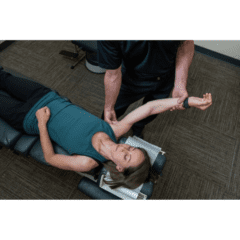Active release technique Treatment in Jaipur
Active Release Therapy (ART) is a type of manual therapy that is commonly used to treat soft tissue injuries and conditions. This technique involves the application of precise, targeted pressure to release tension and adhesions in muscles, tendons, ligaments, fascia, and nerves. Active release technique can be used to treat a wide range of conditions, including muscle strains, joint pain, tendonitis, and nerve entrapment syndromes. Active release technique treatment in Jaipur can help to reduce pain and inflammation, improve range of motion and flexibility, and restore proper function to the affected area.
During an ART therapy, a trained therapist will use their hands to evaluate the texture, tightness, and movement of the affected tissue. They will then use specific, targeted movements to release any adhesions or tension in the affected area. This process may involve stretching, applying pressure, or other manual techniques to help restore proper movement and function.
ART is typically used in combination with other treatments, such as stretching, exercise, and rest, to help speed up recovery and prevent future injury. Your therapist will be able to develop a customized treatment plan based on your specific needs and goals.
If you are interested in ART, it is important to find a qualified and experienced therapist who has been trained in this technique. Your therapist can assess your condition and determine whether ART therapy may be a suitable treatment option for you. They can also provide guidance on the frequency and duration of ART sessions, as well as any other complementary treatments or exercises that may be beneficial for your condition.
Overall, ART can be a highly effective treatment option for soft tissue injuries and conditions. By restoring proper movement and function to the affected area, ART can help to reduce pain and inflammation, improve mobility and flexibility, and promote faster healing and recovery.
How active release technique works
Active Release Technique (ART) is a manual therapy technique that is designed to treat soft tissue injuries and conditions. The technique works by applying precise pressure and movement to the affected area, in order to release tension and adhesions in muscles, tendons, ligaments, fascia, and nerves.
During an ART session, a trained therapist will use their hands to evaluate the texture, tightness, and movement of the affected tissue. They will then use specific, targeted movements to release any adhesions or tension in the affected area. This process may involve stretching, applying pressure, or other manual techniques to help restore proper movement and function.
ART works by addressing the underlying causes of soft tissue injuries and conditions, which often involve adhesions or scar tissue that develop in response to injury or overuse. These adhesions can restrict movement, impair function, and lead to pain and inflammation.
By releasing adhesions and scar tissue, ART can help to restore proper movement and function to the affected area. This can help to reduce pain and inflammation, improve mobility and flexibility, and promote faster healing and recovery.
ART is typically used in combination with other treatments, such as stretching, exercise, and rest, to help speed up recovery and prevent future injury. Your therapist will be able to develop a customized treatment plan based on your specific needs and goals.
Overall, ART can be a highly effective treatment option for soft tissue injuries and conditions. By restoring proper movement and function to the affected area, ART can help to reduce pain and inflammation, improve mobility and flexibility, and promote faster healing and recovery.
